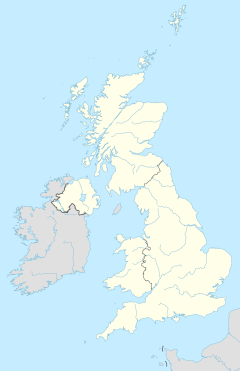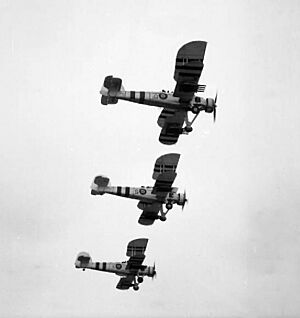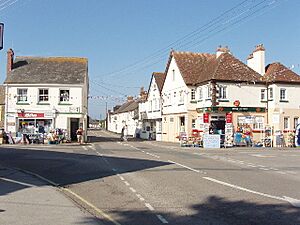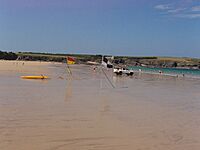St Merryn facts for kids
Quick facts for kids St Merryn
|
|
|---|---|
| Population | 1,606 2011 census |
| OS grid reference | SW881738 |
| Civil parish |
|
| Unitary authority | |
| Ceremonial county | |
| Region | |
| Post town | PADSTOW |
| Postcode district | PL28 |
| Dialling code | 01841 |
| Police | |
| Fire | |
| Ambulance | |
| UK Parliament |
|
St Merryn (Cornish: S. Meryn) is a village and civil parish in north Cornwall, England. It is located in the United Kingdom. The village is about 3.5 miles (5.6 km) south of the fishing town of Padstow. It is also 11 miles (18 km) northeast of the popular coastal town of Newquay.
St Merryn has a primary school called St Merryn School. It is part of the Kernow Learning group. The village also has a vet's office, several shops, and places to eat. There are two traditional pubs here too. In 2011, the village had 1,692 people living in it.
Contents
What is St Merryn Like?
The parish of St Merryn covers about 3,798 acres. A small stream forms its southern border, separating it from St Ervan and St Eval parishes. St Merryn also has over 5.5 miles (8.9 km) of coastline along the Atlantic Ocean. To the north, it borders the Padstow parish.
The area is famous for its "Seven Bays." These are beautiful beaches found along the coast. From west to east, they include Porthcothan Bay, Treyarnon Bay, Constantine Bay, Booby's Bay, Mother Ivey's Bay, Harlyn Bay, and Trevone Bay. Harlyn Bay is the closest beach to St Merryn village, about 1 mile (1.6 km) north.
The coastline has interesting features like the Marble cliffs and Tregudda gorge. Trevose Head is a well-known headland. There is also a collapsed cave called Round Hole. The North Cornwall Coastal Path runs along the clifftops. It crosses all the Seven Bays. The main road in this area is the B3276.
Where Did the Name St Merryn Come From?
There are two main ideas about how St Merryn got its name.
One idea is that the village is named after a Welsh missionary priest. This priest, named Merryn, is thought to have arrived in St Merryn around 650 AD. Some people also suggest that St Merryn was named after a monk called Maruanus or Maruan. It is not clear which Merryn this might have been.
Another theory comes from old church records. In 1259, the church in St Merryn was called Vicaria Sancte Marine. This means "the vicarage of St Marina." It was known as a form of Saint Marina until 1477. Then, it was finally called Seynt Meryn.
Some churches in France are named after a Saint Marina or Marinus. There are also churches in Wales and Brittany named after a Celtic saint Merin. Over time, the earlier Celtic saint was replaced by Marina of Bithynia.
Alban Butler wrote about Saint Marina of Bithynia. She was a woman who lived in the 8th century. She wanted to live like a monk, so she dressed and acted as a man. Her special day is 17 July. The St Merryn feast day was changed to the Sunday closest to 7 July. This was to honor Saint Thomas of Canterbury.
A Look at St Merryn's Past
St Merryn Airfield
RNAS St Merryn was an airfield that operated from 1937 to 1956. It was also known as HMS Vulture and HMS Curlew. At first, it was a small airfield with one runway for civilian planes.
In 1940, it became a military training center. Pilots learned how to fly from aircraft carriers there. The airfield was then called RNAS St Merryn, HMS Vulture. German planes bombed the airfield in 1941. It was rebuilt in 1942.
In 1952, the HMS Curlew unit joined the airfield. They trained Naval reserves and airborne observers. The airfield stopped being used for military purposes in 1956. Today, some parts of the old airfield are used for businesses, farms, and fun activities. You can still see the control tower and other old airport buildings.
St Merryn Beef Shipment in 1999
In August 1999, beef from a St Merryn slaughterhouse made national news. It was the first beef from mainland Britain to be served in Brussels in three years. This was important because it showed that British beef was returning to the international market.
Before this, there was a ban on British beef exports. This was due to bovine spongiform encephalopathy (BSE), also known as Mad Cow Disease. The shipment happened three weeks after the European Union lifted its ban.
Churches in St Merryn
St Merryn Church
The main church in St Merryn was first dedicated to St Merryn. But during Norman times, people thought the saint was St Marina. Later, in 1338, Thomas Becket (Thomas of Canterbury) became a saint. So, the church was also dedicated to him. However, the dedication to St Merryn remained.
The church building has parts from the Norman period. The chancel, south aisle, and the top of the tower were built in the 15th century. The font, which is a basin for baptisms, is made of Cataclewse stone. This stone was quarried nearby. It has carvings of the twelve Apostles. This font originally came from the St Constantine chapel.
The church has a 'wagon roof' built in 1422. Its tower has six bells. The church was expanded in the 15th century with a south aisle. A plaster coat of arms of Charles II is near the tower. The church was renovated between 1887 and 1907, and again in 1962. It is now a Grade II* listed building, meaning it is very important.
Jonathan Toup was a well-known Vicar of St Merryn from 1776 to 1785. There is a small marble tablet in the church in his memory. It says his knowledge was "known to the learned throughout Europe."
The annual summer Church Fete is called "Roses Day Fun." It happens on Feast Day Sunday, which is the Sunday closest to 7 July. There are stalls and activities on 'The Young Men's Green'.
St Constantine Chapel Ruins
The ruins of the Medieval St Constantine chapel can still be seen. What remains are likely the 20 feet (6.1 m) high walls of the west tower. The chapel was probably 40 by 24 feet (12.2 by 7.3 m) in size. It had a nave, chancel, south aisle, and a west tower.
The chapel's roof was repaired in 1290. This was so the Vicar of St Merryn could hold church services there. The chapel's font is now in the main St Merryn Church. Near the ruins, there is a holy well. It was found in 1911. People believed that taking water from this well could bring rain during dry times. The chapel ruins are in the sand dunes near Trevose Head. This area is now a golf course.
St Merryn Methodist Church
The St Merryn Methodist Church is a Wesleyan Methodist chapel. It was finished in 1905. It is a single-story building with a rectangular shape. It has a slate roof and two-light windows. This building is also a Grade II listed building.
The original Methodist chapel was built in the early 19th century. It was made of stone with a slate roof. This old building is now an arts and crafts center. It is also a Grade II listed building.
Local Culture and Traditions
In 1507, a man named Thomas de Tregew gave a small field to the young people of St Merryn. This was for "the celebration of Cornish sports." At that time, these sports included Cornish wrestling and kales.
St Merryn was one of the places where a game called Kayling was played. This game is similar to skittles. It was played in the area from at least the 16th century until the 20th century.
St Merryn was also one of the last villages to have a traditional cornish hurling match. This match was part of their yearly village festival. It was held to honor St Constantine.
In the summer, St Merryn hosts many activities. These include the Great Atlantic Raft Race and the St Merryn Vintage Steam Rally. There is also the St Merryn Carnival and other local events. Sometimes, 'The Amazing Maize Maze' is set up in the area. The Community Hall also hosts auctions and other events.
Cornish Wrestling
St Merryn has a long history of hosting Cornish wrestling tournaments. Records show tournaments happening as far back as 1814. People would compete for prizes.
The traditional place for these tournaments was the de Tregew field. More recently, tournaments have been held in the Green near the Drill Hall. They have also taken place behind the Farmers' Arms pub and at the St Merryn Steam Rally.
In 1965, St Merryn was the host for the Interceltic games. This event brought together athletes from different Celtic regions.
Economy and Tourism
In the past, St Merryn's main industries included tin-mining, smuggling, and fishing. Today, farming and tourism are the most important industries.
There are two old pubs in St Merryn: the Farmers Arms Inn and the Cornish Arms. The Cornish Arms was taken over in 2009 by the famous chef Rick Stein.
Tourism
Most of the Seven Bays have lifeguards during the summer months. They also have car parks and public toilets. Visitors can find many places to stay. These include houses to rent, hotels, and holiday parks for caravans and homes. There are also campsites.
About 2 miles (3.2 km) inland, on land that used to be the St Merryn Airfield, you can find more holiday parks. These include Atlantic Bays, St Merryn Holiday Village, and Maribou holiday home parks.
Famous People from St Merryn
- Kenneth Gray: He received an OBE award. This was for his work with Age Concern and other community programs.
- William Peter: A British diplomat and politician.
- Johnny Cowling: A well-known Cornish comedian.
- Bridget Riley: A famous artist and academic.
See also
 In Spanish: St Merryn para niños
In Spanish: St Merryn para niños








